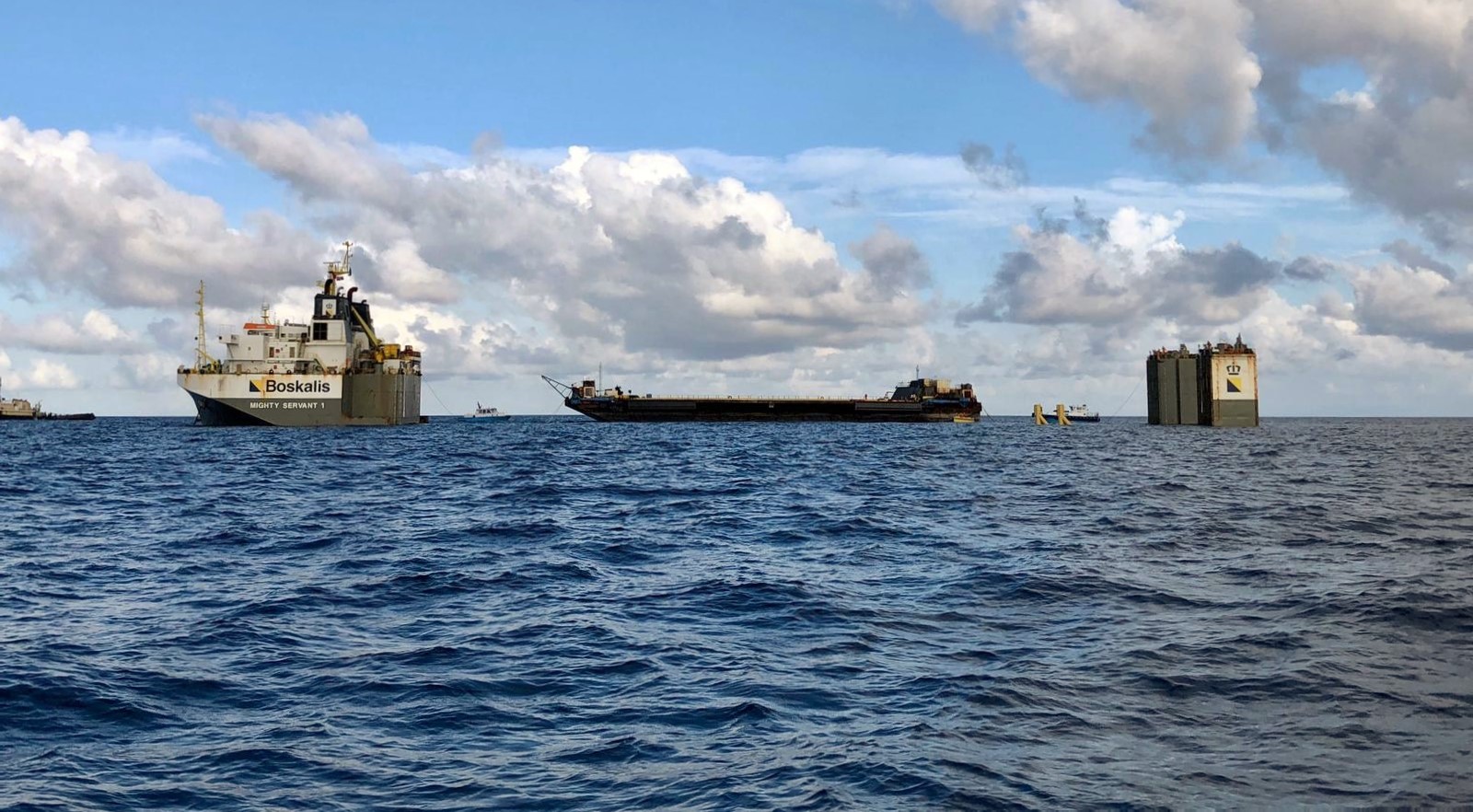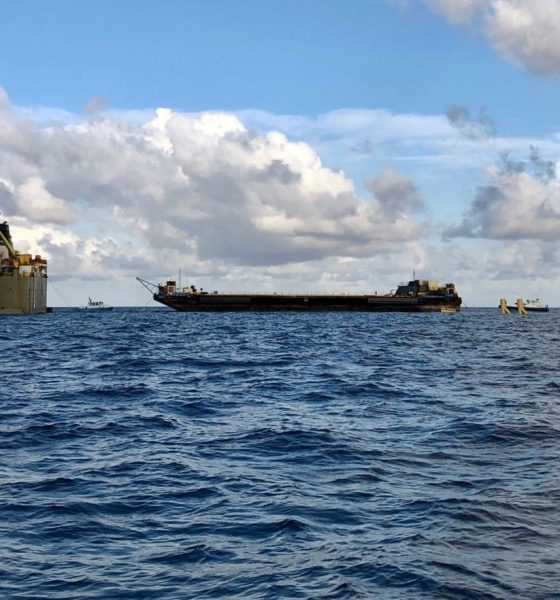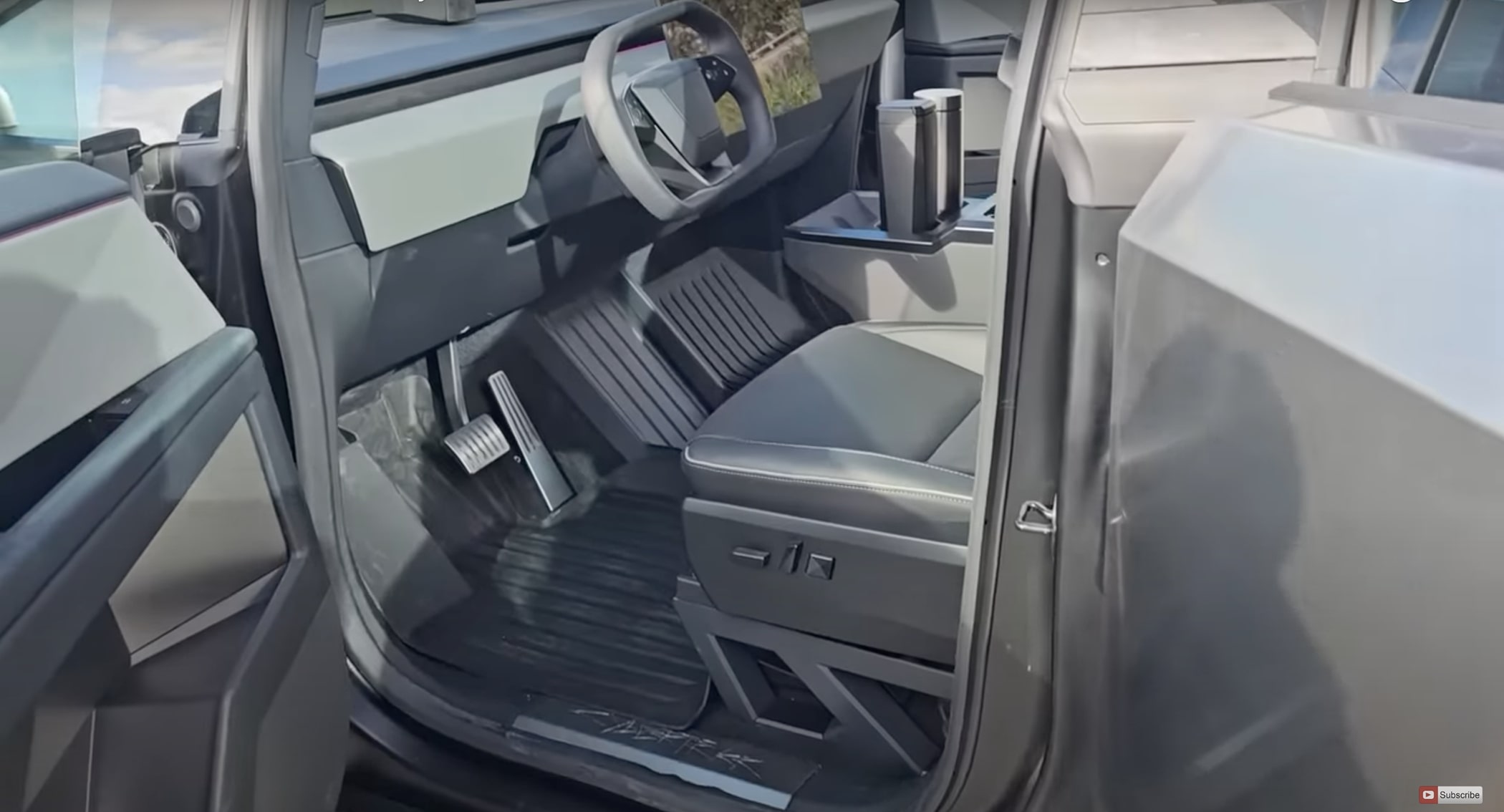

News
SpaceX drone ship to ride transport vessel through the Panama Canal
After a quick jaunt from Port Canaveral to the Bahamas, SpaceX drone ship Of Course I Still Love You (OCISLY) has been loaded onto the deck of a much larger semi-submersible transport vessel.
Known as Mighty Servant 1 (MS1), it appears that OCISLY will be carried from the Bahamas through the Panama Canal – and possibly all the way to Port of Long Beach, California – on the back of the transport ship. That’s unlike Just Read The Instructions’ (JRTI) 2019 transit from California to Florida, which saw SpaceX remove the drone ship’s deck ‘wings’ for a tow through the Panama Canal’s older, narrower locks.
Perhaps possible because of the use of a transport ship like MS1, it appears that drone ship OCISLY will instead be allowed to transit the Panama Canal’s 55-meter-wide (180 ft) New Panama locks. With a one-time permit, SpaceX can bypass its otherwise strict 51.25m (168 ft) beam (width) limit and squeeze drone ship OCISLY through the canal with just 1-1.5m (3-5 ft) to spare on either side. As a result, SpaceX won’t have to go through the relatively laborious process of cutting off and reinstalling OCISLY’s wings and recertifying the drone ship’s seaworthiness, which can easily take a month or more.
More generally, and especially so for a payload as light as OCISLY, Mighty Servant 1 should also be able to travel significant faster than the drone ship would otherwise be able to under tow. Typically, tugboats tend to tow SpaceX’s drone ships no faster than 9 mph (13 kph). MS1 could easily average 14-15 mph with OCISLY on its deck, conceivably speeding up the 5000 mile (8000 km) journey from a bit less than four weeks to two weeks.
While convenient regardless, a substantially faster canal transit and coast-to-coast journey and the freedom to leave OCISLY almost entirely unchanged will help SpaceX begin dedicated polar Starlink launches from the West Coast as early as July 2021. SpaceX COO and President Gwynne Shotwell first put forth a goal of beginning those launches in “summer” 2021 – technically no earlier than (NET) July 2021. Spaceflight Now later confirmed that dedicated polar Starlink launches were indeed scheduled to begin as early as July.
As of June 2021, SpaceX has already delivered a well-worn Falcon 9 booster from Florida to California and the last major missing piece – a drone ship to support West Coast recovery operations – may now be just a few weeks away from Port of Long Beach. In other words, while seemingly implausible just a few weeks ago, SpaceX now has a very decent chance of launching its first dedicated batch of polar Starlink satellites within the next ~7 weeks. Stay tuned for updates on drone ship OCISLY’s Panama Canal transit aboard Mighty Servant 1.

News
Tesla adjusts crucial feature as winter weather arrives

Tesla has adjusted the functionality of a crucial climate feature as Winter weather has started to arrive throughout some parts of the United States. The new feature was highly requested by owners.
Tesla has a Cabin Overheat Protection feature that helps keep the temperature regulated if it reaches a certain threshold. Inversely, it can be used in cold weather as well, which will automatically warm the cabin if it sinks to a temperature that is too low for the owner’s comfort.
This is a great way to keep the cabin either warmed up just enough or cooled down just enough so that it never gets too hot or too cold. Extreme temperatures could damage certain parts of the vehicle or damage personal belongings that are kept inside the car.
Overheat protection is a great thing to have in hot climates like Arizona or Texas, especially with the Premium trims of the Model 3 and Model Y, which feature a glass roof.
Many owners appreciate the feature, but they argue that using it at home will utilize too much energy, especially during extreme temperatures. For a while, many Tesla fans have requested an option to disable this feature when the car is parked at home, which the company recently added, according to Not a Tesla App.
The feature is part of Software Version 2025.44.3, and the release notes state:
“You can now choose Exclude Home when Cabin Overheat Protection or No A/C is enabled.”
Tesla has been great at listening to what owners want with new features, and this is one that will reserve some charge and prevent unnecessary utilization of available power, especially as the car is parked at home. If owners want to condition the cabin or get the car ready for operation with a comfortable interior, they can utilize the Tesla app to adjust the climate.
Elon Musk
Tesla CEO Elon Musk sends rivals dire warning about Full Self-Driving

Tesla CEO Elon Musk revealed today on the social media platform X that legacy automakers, such as Ford, General Motors, and Stellantis, do not want to license the company’s Full Self-Driving suite, at least not without a long list of their own terms.
“I’ve tried to warn them and even offered to license Tesla FSD, but they don’t want it! Crazy,” Musk said on X. “When legacy auto does occasionally reach out, they tepidly discuss implementing FSD for a tiny program in 5 years with unworkable requirements for Tesla, so pointless.”
I’ve tried to warn them and even offered to license Tesla FSD, but they don’t want it! Crazy …
When legacy auto does occasionally reach out, they tepidly discuss implementing FSD for a tiny program in 5 years with unworkable requirements for Tesla, so pointless. 🤷♂️
🦕 🦕
— Elon Musk (@elonmusk) November 24, 2025
Musk made the remark in response to a note we wrote about earlier today from Melius Research, in which analyst Rob Wertheimer said, “Our point is not that Tesla is at risk, it’s that everybody else is,” in terms of autonomy and self-driving development.
Wertheimer believes there are hundreds of billions of dollars in value headed toward Tesla’s way because of its prowess with FSD.
A few years ago, Musk first remarked that Tesla was in early talks with one legacy automaker regarding licensing Full Self-Driving for its vehicles. Tesla never confirmed which company it was, but given Musk’s ongoing talks with Ford CEO Jim Farley at the time, it seemed the Detroit-based automaker was the likely suspect.
Tesla’s Elon Musk reiterates FSD licensing offer for other automakers
Ford has been perhaps the most aggressive legacy automaker in terms of its EV efforts, but it recently scaled back its electric offensive due to profitability issues and weak demand. It simply was not making enough vehicles, nor selling the volume needed to turn a profit.
Musk truly believes that many of the companies that turn their backs on FSD now will suffer in the future, especially considering the increased chance it could be a parallel to what has happened with EV efforts for many of these companies.
Unfortunately, they got started too late and are now playing catch-up with Tesla, XPeng, BYD, and the other dominating forces in EVs across the globe.
News
Tesla backtracks on strange Nav feature after numerous complaints

Tesla is backtracking on a strange adjustment it made to its in-car Navigation feature after numerous complaints from owners convinced the company to make a change.
Tesla’s in-car Navigation is catered to its vehicles, as it routes Supercharging stops and preps your vehicle for charging with preconditioning. It is also very intuitive, and features other things like weather radar and a detailed map outlining points of interest.
However, a recent change to the Navigation by Tesla did not go unnoticed, and owners were really upset about it.
For trips that required multiple Supercharger stops, Tesla decided to implement a naming change, which did not show the city or state of each charging stop. Instead, it just showed the business where the Supercharger was located, giving many owners an unwelcome surprise.
However, Tesla’s Director of Supercharging, Max de Zegher, admitted the update was a “big mistake on our end,” and made a change that rolled out within 24 hours:
The naming change should have happened at once, instead of in 2 sequential steps. That was a big miss on our end. We do listen to the community and we do course-correct fast. The accelerated fix rolled out last night. The Tesla App is updated and most in-car touchscreens should…
— Max (@MdeZegher) November 20, 2025
The lack of a name for the city where a Supercharging stop would be made caused some confusion for owners in the short term. Some drivers argued that it was more difficult to make stops at some familiar locations that were special to them. Others were not too keen on not knowing where they were going to be along their trip.
Tesla was quick to scramble to resolve this issue, and it did a great job of rolling it out in an expedited manner, as de Zegher said that most in-car touch screens would notice the fix within one day of the change being rolled out.
Additionally, there will be even more improvements in December, as Tesla plans to show the common name/amenity below the site name as well, which will give people a better idea of what to expect when they arrive at a Supercharger.








